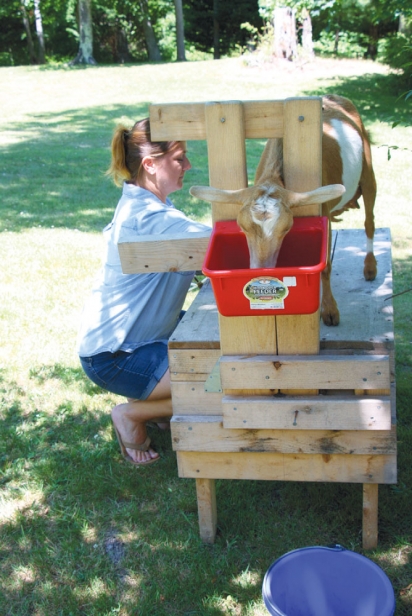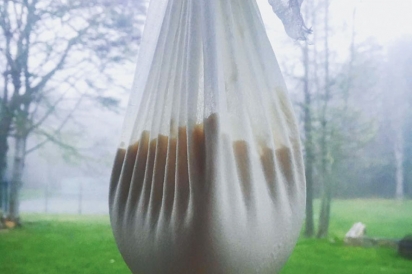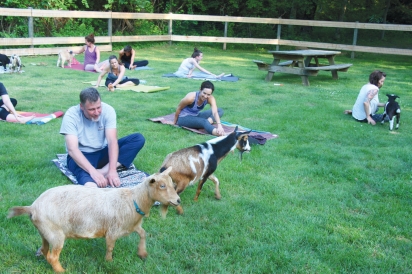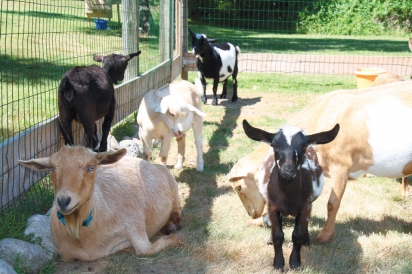No Kidding: The Challenging Trek from Brewster to Brie
The road to chevre is paved with good intentions. The journey is arduous. The obstacles and hurdles are seemingly innumerable. It’s enough to get anyone’s goat, and many would-be cheese makers have given up the ghost in their attempts to make it through the state regulatory gauntlet. For one Brewster native, the mission is a worthy one as she attempts to become the only cheese maker on Cape Cod, with Two Goats Creamery.
When a passion becomes too onerous and costly, one needs to make some difficult choices. So it was for Sadie Hill. After Nauset High School, she graduated from Mt. Ida College with a degree in equine science. Her love of horses led to a career as a horse hoof trimmer, which is different from a farrier, since her work didn’t include shoeing horses. This career path proved to be too much when she took on too many “project” horses. “Every time someone was going to put down a horse, I’d say ‘I’ll take him!’ It became expensive!”
Hill scaled down the focus of her fondness and five years ago began raising Nigerian Dwarf goats. “They’re a lot like horses but are smaller, easier and they give you a product,” Hill points out. It turns out that goats are not unlike dogs when it comes to companionship. “We’ll take them with us,” she says. “They’ll hang out with us while we’re fishing on the jetties.” Goats are a tad more mischievous than dogs, however. One little doe got her head stuck in the wall-mounted wire hay feeder one time. So, away went Hill, the goat and hay feeder to the vet to have him cut the goat free of the metal.
Hill has collected her herd of Nigerian Dwarf goats from some of the best breeders throughout New England and even from as far away as Maryland. The idea of producing a raw milk goat cheese came to Hill shortly after she received her first goats. “About three months later,” she states.
Nigerian Dwarf goats are the perfect choice if you’re looking to benefit from the milk they produce. It contains the highest amount of butterfat at 6-10%. The goats can produce 1-2 quarts of milk per day, which is an astonishing amount for such a small animal, at less than two feet tall at the withers (the highest point of the back). The goats also have the longest period of freshening. A doe freshens (begins to produce milk) when she gives birth. Normally, when the offspring is weaned, the lactation will stop until the next birth. By continuing to milk the goats, they will continue to produce milk.
The Nigerian Dwarfs can produce milk for up to two years. The more demand for milk, the more they will produce it. As mom always said, “You are what you eat,” and what the goats eat throughout the year directly affects the flavor of the milk and, by extension, the cheese. In the spring the cheese tastes light and lemony, and by the fall it takes on a rich, buttery flavor. “I have people that swear I add lemon to the cheese in the spring,” Hill asserts. Currently, she has nine goats, three of which are presently freshening, with two more due to give birth in October. There are two bucks to go along with the seven does. The males reside in West Barnstable where they are put out to stud. They can’t live on the same property as the does because just being nearby causes the females to produce a hormone that negatively affects the flavor of the milk.
After retiring last fall from Nauset Middle School where she worked as a special education teacher, Hill decided to make a go of producing and selling her line of raw milk goat cheeses under the label “Two Goats Creamery,” named after her first two goats, Cee Cee and Gouda. The two words “raw” and “milk”, when used together, can make people a bit nervous about the contamination possibilities and resulting illnesses.
Foodborne illnesses are precisely why there is such a rigorous regulation process food manufacturers must go through to become licensed. If not handled properly throughout the entire process, raw milk (and resulting cheese, butter, etc.) could become contaminated with harmful bacteria and other germs such as Campylobacter, E. coli, Listeria or Salmonella, among others. The standard way to combat these dangers is to pasteurize the milk before proceeding. Remember that it was Louis Pasteur who discovered that if milk is heated at a high enough temperature for a long enough time, the illness-causing germs are eliminated. Starter cultures, the strains of bacteria that begin the cheese-making process, are also wiped out and need to be reintroduced back into the milk after pasteurization to form the cheese curds.
“The bigger, the better” is a phrase that has been disproved time and time again. Controlling the process and protecting the raw milk from contamination is nearly impossible for large dairy farms and creameries given the vast amounts of product that are handled. Yet, it is far more manageable for a small farm to build the proper production facility on-site that can handle the milk of a small herd of goats safely.
“I wouldn’t want more than 15-20 goats in milk [freshening],” Hill explains, regarding the optimal size of Two Goats Creamery. Considering that each goat can produce a quart of milk per day, that could result in upwards of five gallons of milk every day. Each gallon produces two pounds of cheese. When Two Goats Creamery is operating at capacity, over 140 servings of cheese will be turned out per week. In researching other creameries throughout New England, Hill came to an unassailable truth: the facilities that grew too quickly caused the product and the goats to suffer. The goal is to maintain the utmost safety standards, because the key is to preserve the products as raw milk goat cheeses. “The pasteurization process kills off the flavor,” Hills says. “That’s why the big producers are missing it.” Indeed, the flavor of Two Goats Creamery’s goat cheese is far superior. Whether it’s simply with salt or with added honey, herbs, sun dried tomatoes, oregano, figs or any other additions that Hill incorporates, it doesn’t compare to the pasteurized stuff.
The actual process to make the cheese is rather simple. The milk is warmed to precisely 86o Fahrenheit. Starter cultures are added to acidify the milk and create lactic acid. Rennet is then worked in as a coagulant to form cheese curds. The cheese is drained of its liquid whey in cheesecloth until it reaches the proper consistency. Supplementary flavors are then mixed into the cheese, which gets placed into molds for aging or formed into logs for immediate consumption.
In order to get the raw milk cheese to market, however, that aforementioned regulatory mountain does need to be climbed. The list of requirements and procedures is over 30 pages long. That’s enough to stop many before they even get out of the starting gate. The first step is to have the actual milk inspected once a week for three consecutive weeks. State regulators need to sign off on the designed layout of the proposed facility, which in this case will be located in the walkout basement of a beautifully renovated barn on the ten-and-ahalf- acre property.
In addition to the hay and grain storage area, there’ll be six separate rooms, each dedicated to one step of the cheese-making process. The goats enter into the milk parlor—you’re forgiven if images of goats mingling about the parlor chitchatting about everyone’s day while they wait to be milked pop into your head. Hill (or anyone trained to work with her) needs to enter a separate room and change into different clothing to avoid bringing outside contaminants into the processing facility. The goats are moved into the milk room, which pretty much explains what happens there. The milk is brought into the processing room where it is turned into cheese. From there, the cheese is destined for either the packaging room or the adjacent cheese cave for aging different varieties like Camembert and Brie, which Hill plans to offer as well. Hill sprinkles a thin layer of vegetable ash through the middle of some Brie to change the acidity and make a milder cheese. As she says, “Some people like stinky cheese. Some people don’t.”
Once the design is approved and the build-out is completed, the facility needs to pass an on-site inspection. Only when all the steps are accomplished and approvals are given can Hill begin to make and sell her cheese. Two Goats Creamery will need to submit to inspections every three months for the first year before the watchful eye of the state’s department of public health scales back to yearly inspections. This could be why Cape Cod is void of creameries. Yet, the undaunted Sadie Hill charges forward with her dream.
She does so at home with her two kids Callum, 17, and Mia, 11, on land that she newly named Deerfoot Farm. Hill recently came in possession of an antique milk box with “Deerfoot Farm” printed on the side from a friend’s salvage yard. She did some research and discovered that Deerfoot Farm was founded in Southborough, Massachusetts in 1847 by Joseph Burnett. Burnett was a trained pharmacist who provided the anesthetic for the “first public painless surgical operation” in the country at Massachusetts General Hospital. The next year he created the first liquid vanilla extract to be commercially produced and sold in the United States. Deerfoot Farm sausages became world famous, they were the first to bottle their milk in glass, and his son Edward invented a centrifugal cream separator. Needless to say, there are some lofty goals to aspire to in the name Deerfoot Farm. As Hill says with a good chuckle, “When we saw that, we knew we had to step up our game!”
This past summer, Hill expanded the offerings of Deerfoot Farm’s goats to include yoga. Yes, goat yoga is a thing, and it has come to Cape Cod. As one might imagine, goat yoga is exactly as it sounds...yoga with goats. So, now you can perform your downward dog, balancing cat, happy baby or king pigeon poses while baby goats wander around, under or even on top of you while you execute them. Words associated with yoga usually include: peace, serenity, calm. Goat yoga? Hysterical! You haven’t truly laughed until you come nose to nose with a little doe while she stands on your chest, or when a baby billy head-butts your legs as he is standing on your butt. Even for those who have never attempted yoga before, it is a must-do at least once.
There is already a demand for the freshly-made goat cheese of Two Goats Creamery. Several high-end resorts and well-known chefs are eagerly awaiting the day when Two Goats Creamery is up and running and can sell its goat cheese products wholesale. That’s just how Hill plans to keep it: selling directly to chefs and at farmers’ markets. With a shelf life of a mere 10 days, it is the best way to control the quality of the supply. You’ll never see a container of cheese with Cee Cee and Gouda’s mugs on it on any store shelves. “If I wanted to, I could just pasteurize and sell it to Whole Foods,” Hill declares. Hers is a different, tastier path to follow...a more difficult one for sure but a far more rewarding one in the end. Until then, release the goats! There’s cow face and extended puppy poses to strike!











